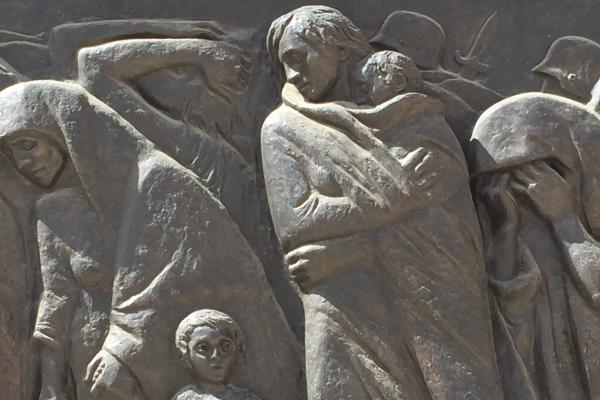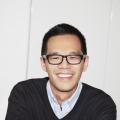Editor's Note: Jeff Chu is on a weeklong group pilgrimage to Rome and the Holy Land, sponsored by the Museum of the Bible. Read parts one, two, three, and four here.
In Chinese culture, names are usually ambitious. They reflect your elders’ desire for your life, and they connect you to something beyond the individual — the family as well as spiritual realms. My Chinese name is Tien Wai—天慧 — which means “heavenly wisdom.” My grandfather, a Baptist preacher, chose that name as his prayer for my life. (He didn’t care that the phrase rings feminine in Cantonese, which people regularly comment on. One of the fun things about Cantonese culture is the lack of boundaries.)
I’ve been thinking about my name again and again on this pilgrimage, as we’ve discussed the idea of the name, the concept of identity, and the question of belonging. How do we label ourselves? With layers. Among the Jews on this pilgrimage, we have Orthodox, Conservative, and Reconstructionist; among the Christians, we claim Catholicism, mainline Protestantism, and various strains of evangelical and nondenominational. Our passports declare that we are American. Our last names tell collective stories — of love and struggle, of migration and adoption. Our first names mark us as individuals.
We’ve talked about interfaith relations. We’ve discussed intra-faith disagreements. We’ve wrestled, explicitly and implicitly, with relations among Israel’s Jews, its Arabs, and all their neighbors. The thread that emerges is the tendency, among all of us, to invest in demarcating what constitutes “us” and who makes up “them.”
So, to forget someone’s name — or, worse yet, to erase it — is one of the most powerful ways to dishonor them. It signals exclusion. It says, “I do not see you” and “I do not respect you.”
On Friday morning — our second full day in Jerusalem — we visited Yad Vashem, the extraordinary museum that serves as monument and memorial to the 6 million Jews who were killed by the Nazis during World War II.
The very name of the museum testifies to the erasure of names: “Yad” means “memorial” in Hebrew, and “Vashem” means name. Together, they allude to the words of Isaiah, who proclaimed an expansive vision of the grace and love of God. “For thus says the Lord,” Isaiah prophesied. “Even to them I will give in My house and within My walls a place and a name better than that of sons and daughters; I will give them an everlasting name that shall not be cut off.” (It's especially intriguing that this prophecy specifically embraces Gentiles who convert and eunuchs, classes of people who were often ostracized..)
Our guide explained to us that “the Nazis tried to take away the names of the victims [so] we try to give them back their names and identities.” And so, throughout the museum, one reads the stories of distinct individuals — people like Wlodzimierz Poczber, who, before his death in 1944 at the Klooga Camp, gave his Cyma pocket watch to two nephews, who survived. And Chaim Klieger, who, while living in the Warsaw Ghetto, made for his little sister, Sarah, a brooch that includes a representation of a bread-ration card. And Aristides de Sousa Mendes, who, as Portuguese consul-general in Bordeaux, issued entry visas for thousands of French Jews; was disciplined and lost his job; was not exonerated until more than three decades after his 1954 death; but was declared “Righteous among the Nations” for his lifesaving support of the Jewish people.
At certain moments, too, the exhibits remind us of the names of the perpetrators. There’s one wall that shows a group of Hitler advisers, men — and, yes, they were all men — who helped him with his meticulous genocide plan. Some of the names are more easily recognizable: Adolf Eichmann, for instance, and Reinhard Heydrich. But one was a man previously unknown to me. Named for a pastor who served in Germany hundreds of years before, he was a Hitler adviser. His name: Martin Luther.
--
I don’t want to say much more about Yad Vashem. I’m still processing. I know that it is the most moving museum experience I’ve ever had. But it seems almost sacrilegious to call it a museum, because, really, it is sacred space. If you have never been, and if you go to Jerusalem and do not make time for this, please never tell me.
Of course it’s easier to erase someone’s name and negate someone’s identity when you choose to see them as alien and non-human. According to our guide at Yad Vashem, the Germans were so set on “othering” that they created a new word for the Jews: untermensch, literally “sub-human.”
This pilgrimage has been so powerful because of the many moments when we’ve done the opposite: We’ve been invited to step into someone else’s corner of the world, to try to see things from their perspectives, to accumulate concrete evidence for building empathy.
One of the most stunning examples: On Friday evening, we went to the Western Wall to welcome the Shabbat Queen, as they say here. The wall is the lone remnant of the Second Temple that was destroyed by the Romans in AD 70, and on Friday evenings, the atmosphere is particularly celebratory.
Most of us had written prayers to tuck into the crevices of the wall, and as we approached it, we were enveloped into the sea of worshipers who had gathered to pray: Hasidim with their massive, cylindrical black fur hats; dads in finely tailored suits, carrying their toddler kids; young Israeli men about to begin their military service. There were outliers — and not just the non-Jewish members of my group; one American tourist, clearly an evangelical, lifted his arms in the air and prayed loudly, eyes closed, seeing no one, for the redemption for the Jewish people.
At Shabbat dinner afterward, Josh Hailey, a member of our group who quickly won a place in my heart with his wryness and his wisdom, spoke movingly about the experience of praying at the Wall. He’s a gifted photographer, so it’s no surprise that he was struck by the visuals of the space. He looked different from the others there — that night, he was wearing a grey suit, a loosely knotted tie, and a shirt unbuttoned at the collar — but more importantly, he felt different.
It wasn’t so much the spiritual element. His epiphany had more to do with how, as a straight, white guy in America, he’s never felt like part of a minority. Standing at the Western Wall, amid people whose lives are so distinct from his own, he felt reaffirmed that, as a leader in his church, his calling is to create a sense of welcome for those who might feel alienated, in whatever way and for whatever reason. Praying at the Western Wall, he said, “gave me a different lens.”
We need these different lenses. And as I listened to Josh, I thought about how we need this different kind of naming, too: Giving voice to the kind of awareness we should cultivate. Saying aloud the type of understanding we need. Speaking our aspirations. I wonder, though, whether it will ever be enough.
Got something to say about what you're reading? We value your feedback!

